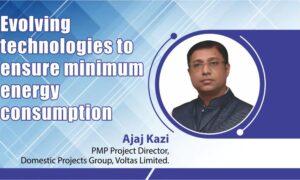In the near future we do believe that with technologies like Digital Twins combined with AI, buildings will become prosumers instead of consumers.
Anuraga Chandra, Head, Cooling Sales, Danfoss India
Danfoss India is a 100-percent owned subsidiary of Danish multinational company Danfoss Group. In an interview with TCBU, Anuraga Chandra, Head, Cooling Sales, Danfoss India said, an integrated and optimised HVAC system can be transformational in enhancing a building’s energy efficiency and reducing its carbon footprint throughout its lifecycle.
Could you brief us on the role of HVAC systems in a green building?
Green buildings are those that are structured to be energy and resource efficient from a design and an operational and maintenance perspective. With an increase in urban sprawl and migration, it has become imperative that all commercial and residential structures be mindful of their energy consumption and carbon emissions wherein HVAC forms one of the most important factors in making a building green. One of the key learning that Danfoss has gleaned from the ACREX Hall of Fame over the years is that, for most buildings in India, the energy performance index is 30-40 percent lower than the original design intention .
It is well documented that the heating and cooling requirements of buildings constitute nearly 50 percent of their total energy consumption. This is further exacerbated by the rising temperatures and the increasing number of people remaining indoors and the consequently increased cooling needs. HVAC systems play an important role in not only reducing the energy and carbon footprint of the building but they are also critical for ensuring good indoor air quality (IAQ).
An integrated and optimised HVAC system can be transformational in enhancing a building’s energy efficiency and reducing its carbon footprint throughout its lifecycle.
What is the most advanced HVAC solution trend for green buildings?
We studied the top buildings which are most energy efficient in India and released our recommendations at the ACREX Hall of Fame 2020. What we have observed is that the design phase is the most important aspect to have the optimal solution and thereon it is important to have people with the right skills operating these systems.
We recommend a three-stage approach during the designing phase where the first is to minimise the cooling needs with the right orientation of the building, proper use of daylight etc. We then recommend that there be an efficient cooling delivery system with proper use of variable speed systems, oil free technologies as well as refrigerants and chemicals which are less harmful to the environment. Systems such as radiant cooling that combine heating and cooling requirements will find much value here while also providing the essential service of ensuring proper fresh air circulation.
Lastly it is important to use sector coupling where we combine energy sources such as renewables with energy storage towards making buildings effectively net positive energy contributors rather than energy consumers. In the near future we do believe that with technologies like Digital Twins combined with AI, buildings will become prosumers instead of consumers.
There are several trends in HVAC solutions that can enhance the efficiency of green buildings. For instance, predictive and condition-based maintenance systems in buildings can vastly increase the uptime and efficiency of the system, ensuring timely maintenance. This has a wide range of benefits such as, the air filters never get clogged, and motor load is kept within limits, etc.
Another common feature of modern HVAC for green buildings is the use of refrigerants that have low global warming and ozone depletion potential in lieu of traditional refrigerants such as HFCs, CFCs and HCFCs, thus significantly reducing the carbon emission levels of the buildings.
Digitalisation of buildings (smart buildings) is significant from an HVAC point of view. Enabling a seamless integration and connectivity between the building management system and the HVAC system can enhance safety, reliability and process efficiency, thus reducing the overall energy spend for buildings.
What are the trends you foresee for HVACR industry post COVID-19 era?
The outbreak of the COVID-19 pandemic has brought about a series of changes across sectors. The nationwide lockdown implemented owing to safety considerations has highlighted the importance of a safe HVAC system. As mentioned earlier, more people staying indoors and the subsequent increase in cooling requirements, has made it ever more important to ensure efficiency and safety in HVAC systems.
Going forward, while entering a new phase of our economic history and establishing the ‘new normal’, arriving at a low-touch low-carbon strategy to revive the economy will be essential. We must bear in mind that economic growth can no longer be achieved at the cost of sustainability and the outlook of the future must be that of a ‘green-restart’ of the economy.
A key driver for this will be a complete digital transformation of the HVAC-R industry. This will include integrated building management systems, connected devices enhanced with remote operation and management capabilities and most importantly, the enabling of digitalised delivery and sales models. IoT based solutions can reduce human intervention for critical maintenance and operational processes. At Danfoss, solutions such as VFDs and Turbocor compressors are already replete with these capabilities.
At this juncture, it is imperative to continuously assess the needs of the industry and align R&D and innovation efforts to meet said needs. Additionally, the air conditioning industry has been seen as a ‘dirty industry’ as it uses chemicals and contributes to excessive waste heat that gets released into the environment. Decarbonising can be the turning point in positioning the HVAC industry as India’s next ‘sunrise industry’.
India has the potential to take the lead in not just decarbonising HVAC but can also become the global hub for manufacturing. We must work in collaboration with policy makers, the government, manufacturers, R&D, educational institutions, etc. towards developing ‘future proof products’ at a cost and quality which is world-class.
Cookie Consent
We use cookies to personalize your experience. By continuing to visit this website you agree to our Terms & Conditions, Privacy Policy and Cookie Policy.















